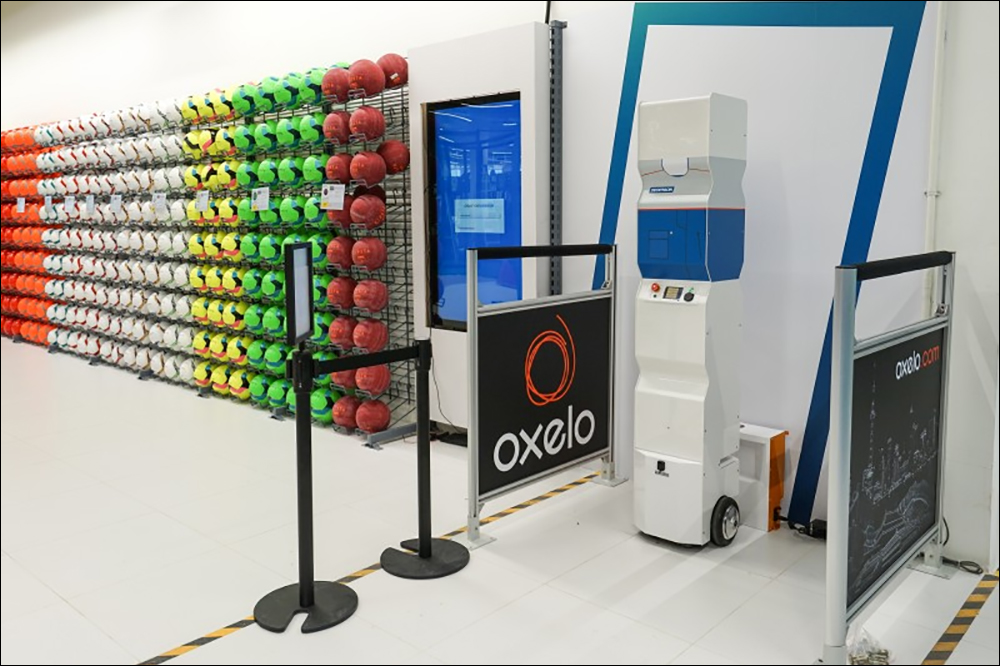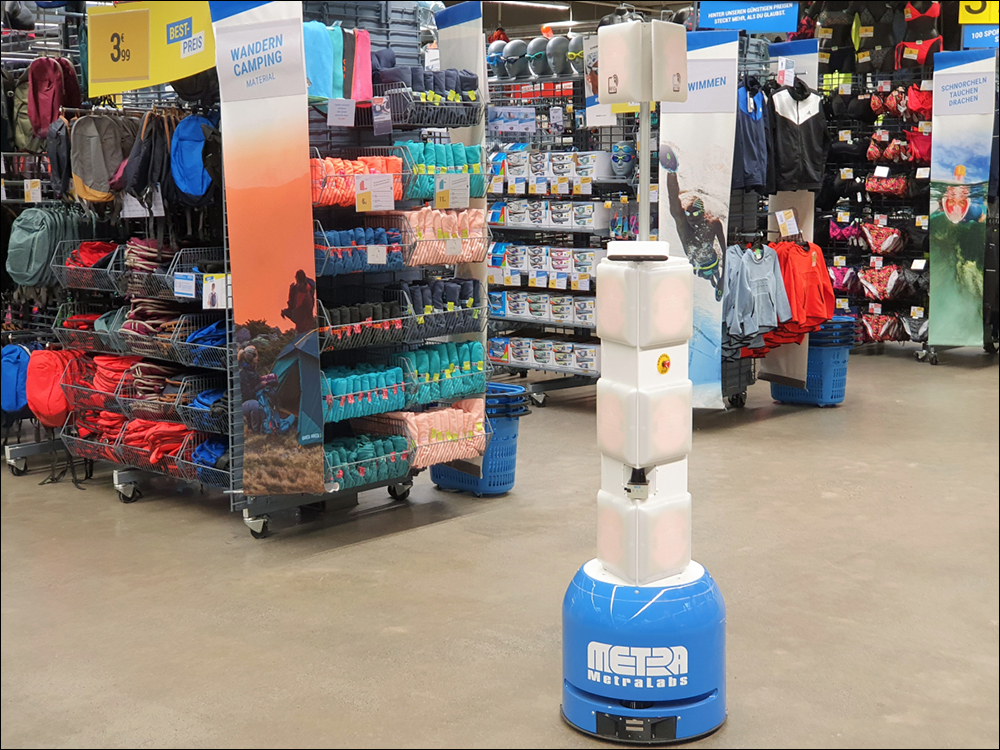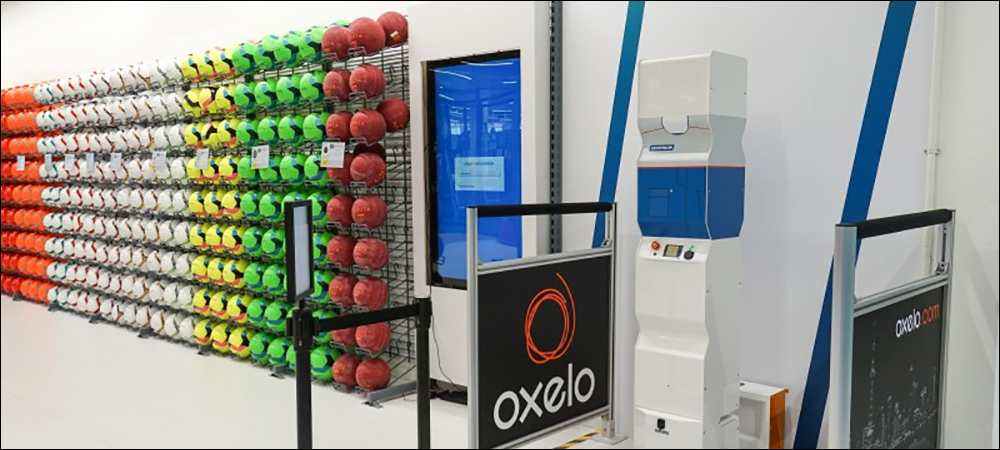Global sporting goods company Decathlon reports that it is furthering the value it gains from its use of radio frequency identification technology for inventory management and supply chain efficiency, most recently by rolling out inventory-counting robots. The latest robot to be adopted is MetraLabs‘ Tory robot that captures tag reads as it navigates and maps out the locations of goods throughout stores. Tory joins Pal Robotics‘ robot, which has also been piloted and deployed at some Decathlon locations.
Decathlon is reportedly the largest sporting goods retailer in the world. The company is sharing its learnings, acquired from more than a decade of technology testing and deployment, with other retailers and global corporations that have faced challenges in deploying RFID systems, says Hervé D’Halluin, Decathlon Worldwide’s RFID and traceability leader. The brand and retailer serves as a consultant to these businesses as they work through the selection, testing and implementation stages of RFID deployments.

Decathlon has deployed Pal Robotics’ robot at some of its stores.
The company designs and produces its own products under 20 brands, and it sells goods ranging from clothing to bikes and cardio machines, both online and from its big-box stores located in approximately 60 countries. The retailer’s RFID journey started in 2009, when it began tagging and tracking goods to boost inventory accuracy in the supply chain and at stores. In 2013, Decathlon leveraged handheld readers to enable workers to capture inventory data (see Decathlon Sees Sales Rise and Shrinkage Drop, Aided by RFID, Decathlon Scores a Big Win With RFID, RFID Reading Robot Automates Decathlon Store’s Inventory Management, and Best RFID Implementation: Decathlon).
RFID-based Self-Purchasing
Every piece of merchandise the company sells now comes with an RFID tag and a digital identity linked to that tag’s ID number to provide visibility at distribution centers, into stores and throughout the sales process once the tags are removed. At some stores, Decathlon also offers self-purchasing via an RFID-enabled kiosk, where customers can use an RFID reader to scan the tags of the products they purchase, then complete their payment transaction. This reduces delays while customers wait in line—a process for which shoppers, accustomed to one-click purchasing online, are less likely to have the time or patience.
In recent years, D’Halluin says, the need for highly accurate inventory in stores has gained greater importance for meeting omnichannel requirements. The COVID-19 pandemic led Decathlon to close some stores, while sales shifted to more omnichannel purchasing, with customers ordering goods online and either picking up their purchases at the nearest store or requesting them to be shipped directly to their homes from the neighboring store. To meet these needs, Decathlon relies on the RFID tag data to ensure inventory counts at the stores shipping the goods is highly accurate.

The sporting goods retailer is now rolling out tracking robots from MetraLabs as well.
The use of robotics to capture the ID number of every tagged item on display or in the back room, D’Halluin says, can make that inventory data more accurate at the stores in which the robots are being employed. The traditional method of reading passive UHF RFID tags attached to merchandise throughout a store via a handheld reader can be labor-intensive. Although a reader can capture tag IDs more efficiently than manual stock counts, the process of reading tags still takes store associates away from their other tasks and can require hours of time for them to walk throughout the entire store. For that reason alone, inventory counts may not take place as often as the company would like.
Frequent Inventory Counts with Robotics
While weekly inventory counts may have been enough for stock accuracy in the past, D’Halluin says, omnichannel sales requires more timely data. If inventory quantities are limited to just a few of each single item, and if local shoppers are buying them online, a weekly inventory count may not be sufficient to ensure products being purchased will be available immediately for each buyer. The RFID reading robots, therefore, enable stores to capture inventory counts more often, such as once daily. When data is collected regularly, he explains, stores can be assured that they have inventory on hand when orders are placed.
Decathlon first tested the robots during four separate pilots in four countries: China, Russia, Singapore and the United States. The results, D’Halluin says, showed that inventory could be made more accurate and thereby boost sales as the omnichannel method of purchasing becomes more commonplace. Since the pilot was conducted, Decathlon’s stores have begun leveraging the RFID reading robots throughout 20 countries. “We are increasing the number of stores using the robots,” D’Halluin states.

Hervé D’Halluin
However, D’Halluin notes, no store is required to implement the robotics technology. Rather, adoption is the choice of store management in each country. “They decide whether to invest,” he says. “We just explain to them that we have two [robotic technology company] sources that are available all over the world, that are supported by the system.” He adds, “They are allowed to plan it this year or next year, or in two years or in three years. It really depends on their priorities.”
However, D’Halluin says, “I think this transition is going to increase in terms of speed because of the success of the stores that have implemented it.” The Tory robot provides continuous live operation, according to Andreas Bley, MetraLabs’ managing director. As the robot passes throughout a store, capturing RFID tag reads, it immediately forwards the collected data to a user’s software. The robotic data is managed by Decathlon’s own software to confirm inventory data and trigger replenishments.
“Basically, the robot is only there to do more readings,” D’Halluin says, providing a tool for counting goods, while the inventory data ultimately relies on the management software to interpret that information and thereby ensure omnichannel availability. “It’s mixing the physical and digital worlds,” he states, by leveraging reliable, automated inventory counts, along with the appropriate data to enable click-and-collect or other purchasing options. The robots can be used during off-hours or when a store is open. For stores that have long hours, this feature ensures that inventory is counted regularly, whether or not there is an opportunity with no customers in the store.
Sharing Knowledge

Andreas Bley
Decathlon is sharing its robotics experience as part of the RFID consulting services it offers to other retailers and industrial companies. The consulting services began approximately two years ago, following conversations the company had with a variety of large corporations interested in learning about what the retailer had accomplished via RFID. “They came to us and said, ‘We don’t know how you made RFID work, because we aren’t seeing the value of it,'” D’Halluin says Their lack of success was related to the approach being taken during deployment, Decathlon discovered. “We decided to help a few big retailers,” and that effort has led to professional consultation services.
“RFID is a tool,” D’Halluin states, but some companies deploy it without an organized approach focused on the gains they hope to achieve, and on how they will mobilize management and animate users to leverage it properly. Customers come to Decathlon from a wide variety of sectors interested in traceability, he says. “If you are able to master something to the level that you are a world champion [at it],” he states, “that knowledge should be interesting to many different players.” The company expects to gain from RFID adoption by others in retail and beyond. “It will be in the interest of Decathlon to support big companies to do their own migration and use the technology,” D’Halluin says, and Decathlon continues to expand the robotic system’s use throughout its stores.
There are a series of steps to complete for a robotic deployment, Bley explains. Users must first prepare a place for the robot charging station. MetraLabs delivers its Tory robot directly to users, sets up the system for data exchange and remote access, and also provides mapping and testing. “First, we do a manual mapping so we drive the robot through at least certain parts of the store,” he states. The robot then stores data regarding the store map so that it can follow the path with each inventory count.
The Tory robot can remap the store autonomously, Bley says, as merchandise is moved or rearranged. “Since something changes every day in a store,” he states, “we developed [Tory’s navigation software] further so that the bot is able to map the store by itself.” This remapped data enables retailers to view changes in their store map in 2D as displays and products are repositioned.
The Tory can pinpoint an RFID tag’s location within 2 or 3 feet, based on its perceived location within the store, as well as the angle of arrival and signal strength of the RFID tag’s response. That data is then forwarded to the server via a Wi-Fi connection. In general, it typically takes about four hours for the Tory robot to cover an entire store and capture all tag reads. Bley says companies using the robot typically gain a return on their investment within one or two years, based on improved inventory accuracy and subsequent sales boosts.
When used in open stores with customers, the company reports, the robot can include a touchscreen that enables customers to select an item for which they are searching, so that they can be directed by the robot to the proper location. Additionally, the data can be used in a retailer’s app so that customers can view the current store layout and location of the merchandise they are seeking. European clothing retailer Adler Modemärkte was the first company that deployed MetraLabs’ system, and the robot is also being used in factories and museums, as well as for research and education.
Key Takeaways:
- Decathlon has taken the approach of innovator, by testing and deploying RFID systems early and sharing with other companies.
- Robotic RFID tag reading is the latest functionality aiding in inventory management in stores.
Exhibitors at RFID Journal LIVE! 2022 will offer solutions for tagging sporting goods, including RFID and robotics technologies. To learn more, visit the event’s website.


